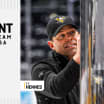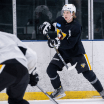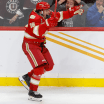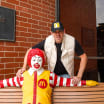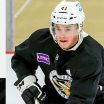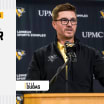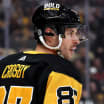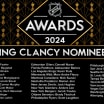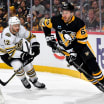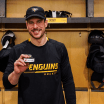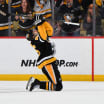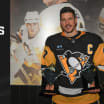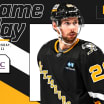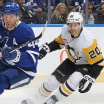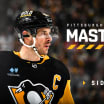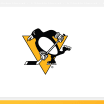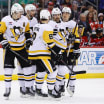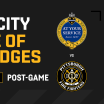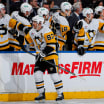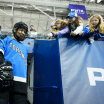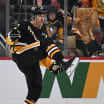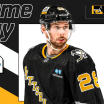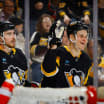It's been both an exciting and busy season for Penguins director of amateur scouting Patrik Allvin and his staff as they prepare for the 2019 NHL Draft, set for June 21 and 22 in Vancouver. It will be the accumulation of watching hundreds of games in various leagues and international tournaments.
"We're all looking forward to it," Allvin said. "This is the highlight for the amateurs that work so hard the whole year."
Inside Scoop: The Pens' scouting process
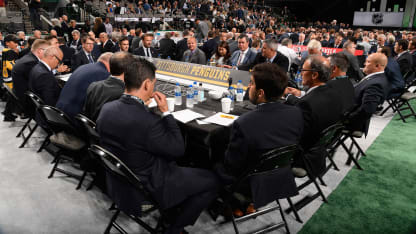
The process for this year's draft started ramping up last August, when the regional scouts - or "area guys," as Allvin calls them - began building their schedules based around seeing the top-end players in their respective areas. From there, Allvin and the Penguins' crossover scout Colin Alexander crafted their schedules accordingly.
Watching games in those early stages, it's all about identification - getting a feel for the players and getting a sense of who they want to come back and watch.
"When you start scouting in the fall you want the players to come to you, for sure," Allvin said. "You circle in a couple guys that are up for the draft, and you usually give one team the first period and the other team the second period. By the third period, you have circled them in a little bit more. You're looking for more specifics."
Towards the end of the first half, the scouts gathered together for a mid-term meeting to check on their progress.
"That's the first time we get together and see, okay - generally, where do we have our players?" Allvin said. "What are we looking for in the second half? What do we want to see here? What are the question marks?"
All of the area scouts got homework to follow up, and then headed off to their respective regions. As their focus started to narrow onto specific players and their monthly progression, it was important for Allvin to stay in contact with each of the area scouts.
While he tried to watch certain players a "handful" of times a year, the responsibility lies primarily with the regional scouts to handle the due diligence. So every day, Allvin read their reports and followed up on any questions or concerns.
"I like to challenge the area guy to go back and watch him again," Allvin said. "We might have a disagreement on the skating. I might think a guy is a good skater and the area guy might think he's just an average skater, so I want to make sure we clear those things up."
A player's on-ice abilities are only part of the equation. The Pens scouting staff want to know every single detail about a prospect's character and life.
"We want to know everything," Allvin said. "I don't want any surprises after we draft a player. We want to know as much as possible."
It starts with meeting the players themselves, which can be accomplished in different ways. Some scouts prefer to talk with them at the rink, others - like Allvin - like to chat with them away from the rink.
"I prefer to take them out in different settings where players feel more comfortable and relaxed," Allvin explained. "I think at this young age, you're nervous and some of them might be really prepared from the agents and stuff like that. You want to try to get to know the real player, the real person. In order to do that, if you can get them to lunch or coffee or whatever, in a more relaxing environment, I think that's where you can get to know them best."
The scouts also speak with coaches, members of management, the billet families, teachers and administrators - anyone who has a relationship with the player and can speak to what they're like - and try to meet with the parents.
"If a player is 150 pounds and 5-10, you want to see how the mom and dad look, see if there's (potential) growth down the road," Allvin said.
Allvin said it's important to remain open-minded throughout the process, because a lot can change for these teenagers who are just 17 and 18 years old. They're trying to project what these players will be like when they're 24 or 25 years old, so the main thing they look for is continued improvement throughout the course of the year.
"Some of them, they might be fully-grown already. And some of them might be more of late bloomers and coming along in the second half," Allvin said. "What we want to see is improvement in every area of their game."
As the end of the season approached, the staff had several conference calls before getting together for their final meeting at the end of May. Over the course of four days in Pittsburgh, the group took the rankings from each region and put together an overall ranking of the players.
"That's the biggest challenge, getting the players in the right order," Allvin said. "It's tough, because you see a lot of passion from each area scout. They've been following those players, some of them for two years. And they've done their due diligence and you respect it. So it's my job and Colin Alexander's job to get it in the right order here."
After that, the group headed to Buffalo for the NHL Scouting Combine, where the 103 top draft-eligible prospects went through fitness testing and interviews with the team.
"You get 15-20 minutes, almost like speed dating," Allvin said with a laugh. "You see the different personalities."
As the main global scout, Allvin doesn't always get enough time with certain players during the course of a season. This is his opportunity to get some face time.
"With the combine it's great for me to get a chance to meet and see every single (player), but our area guys are doing a tremendous job out in the field gathering all the information so I can read into it," he said. "Leading up to the combine, I'm reading the reports from our area guys, what they've seen. And I just want to get a chance to sit down with those kids for 15 minutes and meet them. We also make sure we're taking a couple of players out every night for dinners, (players) that we want to spend a little bit of extra time with and get to know a little bit better."
After the NHL's combine concluded on May 31, the Penguins hosted their own combine on June 1 that select players were invited to. After that, the group again got together to recap, go through all of the reports and update their list, which makes up the Penguins' draft board from which they will make a majority, if not all, of their selections.
The final list is an ongoing process until the morning of the 21st, when they will turn it in to Penguins general manager Jim Rutherford before the first round of the NHL Draft begins that night in Vancouver.
The Penguins have a first-round pick for the first time since 2014 (read more about that here), which they're excited about. But they're also thoroughly prepared to make every single pick count.
"I think scouts are very competitive," Allvin said. "We are competing against 30 other teams. We want to be the best. If we only have three picks, we want to make sure we nail those picks. Sometimes you're going to look for different characteristics, that you know this kid might not be perfect. But four, five, six, seven years down the road, with our help, he might have enough traits that will get him to the NHL."

